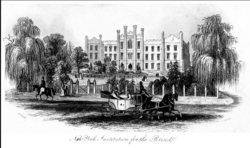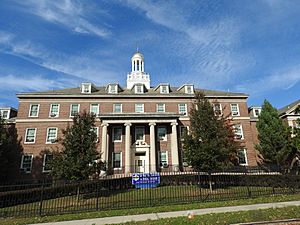New York Institute for Special Education facts for kids
Quick facts for kids New York Institute for Special Education |
|
|---|---|

1851
|
|
| Address | |
|
999 Pelham Parkway North
10469
|
|
| Coordinates | 40°51′31″N 73°51′34″W / 40.858617°N 73.859438°W |
| Information | |
| Type | Private, Special, Day & Boarding |
| Established | 1831 |
| Sister school | Overbrook School for the Blind |
| Executive Director | Bernadette M. Kappen, Ph.D. |
| Grades | P–12 Students aged 3 to 21 |
| Accreditation | National Commission for the Accreditation of Special Education Services |
The New York Institute for Special Education (NYISE) is a private school in New York City. It is a non-profit organization. The school first opened in 1831. It was started by Samuel Wood, a kind person who helped others, and two doctors, Samuel Akerly and John Dennison Russ.
The school was originally called the New York Institute for the Education of the Blind. It was created to help blind children learn. The first location was in Manhattan, New York City.
In 1986, the school changed its name to the New York Institute for Special Education. This new name showed that the school now helped more students. It began to offer programs for children with learning and emotional challenges, as well as those who are blind. Today, the institute helps children from birth up to 21 years old.
Contents
How the School Started
Samuel Wood was a rich publisher of school books. He had been a teacher before. He noticed that there were not many reading books for children. So, he wrote and published a simple reading book called The Young Child's A B C, or First Book in 1806.
Wood also saw blind children in the city's poorhouses. Their future looked very difficult. He likely heard about groups in Boston that wanted to train blind people. Wood was in his sixties and enjoyed helping others.
Samuel Akerly had worked for ten years as a leader and doctor at the New York Institution for the Deaf. He helped create ways to teach deaf people. Then, he became interested in doing the same for blind people. Akerly knew how to suggest new laws. He, Wood, and 15 other citizens asked the New York State Legislature to create a school. They wanted an institution to "improve the moral and intellectual condition of the Blind." They also wanted to teach them useful jobs. The law passed, but it was changed to only help children.
John Dennison Russ was also a kind doctor who wanted to help. He had planned to teach blind children in the poorhouse on his own. Then, Akerly told him about the new school. Russ worked as the first teacher without pay. His first class had three blind orphan boys from the poorhouse. They learned in a private home on Canal Street. After two months, three more boys joined. The school then moved to Mercer Street. Teachers learned what worked best by trying different methods. At the end of the year, the students showed what they had learned. This made the public interested and brought in more help and donations.
Early Growth of the School
By 1833, ten more students joined the school. Four of them were girls. In 1834, New York State started paying for some students. New Jersey also began sending children to the school. By this time, there were 26 students in total. Russ had help from other teachers. One taught school subjects, one taught job skills, and one taught music.
According to the school's history, Dr. Russ did amazing things. He taught his students and managed the school. He also invented tools for blind people. He tried to find a way to make books smaller for those who could not see. He even suggested a new alphabet with dots and lines. He also made better ways to show maps for blind students, based on ideas from European schools.
While teaching, Russ also kept his private doctor's office. But the school moved from Spring Street to a bigger place. This new spot was far away, at Ninth Avenue and 34th Street. This made things difficult for Russ. He left the school in 1835.
Famous Students and Teachers
19th Century Figures
Fanny Crosby was a poet who wrote the words for thousands of Christian songs. She was both a student and a teacher at the institute. She had been blind since she was a baby. She joined the school in 1835 when she was 14. She studied there for 9 years. Then, she taught at the school from 1847 to 1858.
Grover Cleveland and his brother William worked at the school in 1853 and 1854. This was when Fanny Crosby was teaching there. At that time, there were about 116 students. Their ages ranged from 8 to 25. About half were boys and half were girls. William taught older students history, philosophy, and basic science. He did this to help pay for his studies to become a minister. He convinced the school to hire Grover. Grover worked as a bookkeeper and taught younger students basic subjects like reading, writing, math, and geography. Neither brother was trained to teach. They often had to learn just ahead of their students.
The food at the school was not good. The pay was low, and the buildings were cold and damp. The superintendent was very strict. He made life hard for both students and teachers. The Cleveland brothers later said their time at the institute was the hardest part of their lives.
Fanny Crosby and Grover Cleveland were lifelong friends. Crosby wrote down her memories of Cleveland's time at the institute. She did this when he first ran for president. She said Cleveland was a hard worker. She also said he encouraged her to stand up to the strict superintendent.
William Bell Wait was a teacher at the institute. He invented New York Point. This was a writing system for blind people. It was used a lot in the United States before the Braille system became popular. Wait also invented the Kleidograph. This was a special typewriter with twelve keys. It was used to print New York Point onto paper.
20th Century Figures
Ed Lucas was a student at the school. He became a sports writer, a broadcaster, and a speaker who inspired many people.
4201 Schools Association
The NYISE is part of the 4201 Schools Association in New York. This group helps special education schools work together.
See also
- Blindness and education


